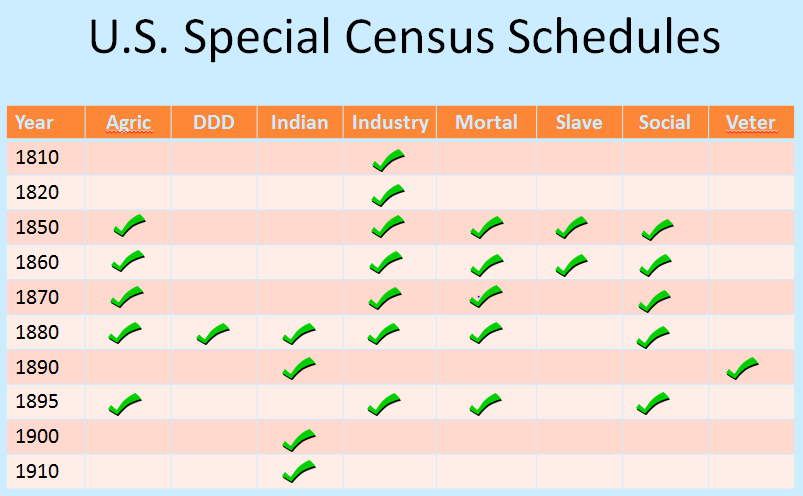What’s So Special about US Special Census Schedules?
 Who should pay attention to the US special census schedules? Anyone whose relatives appear in the US census between 1850-1880 (and some whose relatives show up in 1810-1820 and 1890-1910).
Who should pay attention to the US special census schedules? Anyone whose relatives appear in the US census between 1850-1880 (and some whose relatives show up in 1810-1820 and 1890-1910).
Many records about our ancestors point to even more records. Such is the case with the US Census. For many decades, the census records we most commonly consult are actually just “Schedule 1” of several census forms in which your ancestors may appear. Better yet, many of the surviving special census schedules are now online at Ancestry.com and other genealogy websites.
So who should be paying attention to surviving US special census schedules? Everyone whose ancestors:
- Appear in U.S. censuses between 1850-1880;
- Worked in industrial occupations in 1810-1820;
- Were veterans of the U.S. Civil War and still alive in 1890;
- Were Native Americans in 1900-1910.
Here’s a quick table showing the years for which the following schedules survive (for at least some locations): Agricultural; Defective, Dependent and Delinquent; Indian, Industry/Manufacturing; Mortality; Slave; Social and Veterans Schedules.
What’s in the US special census schedules and where can I find them?
Depending on the year and the schedule type, you may discover information about recently-deceased ancestors (in the mortality buy medicine online kolkata schedules, 1850-1880); disabled or institutionalized ancestors (in the 1880 DDD schedule); enslaved or slave-holding ancestors (in the 1850-1860 censuses); Civil War veterans (1890 only); farmers (1850-1880) and more. Some of what you’ll find may be uniquely revealed in the US special census schedules.
Many of the special schedules have been digitized and indexed and are available online. Especially for 1850-1880, when so many schedules were created and so many different people were included, it’s worth searching for your ancestors in each one.
The syllabus for my RootsTech lecture, “Whats Special about US Special Census Schedules?” includes a detailed summary of what’s in each special schedule, where to find them (online and offline), and additional tips that may help you get the most out of them.
Remember: for many years, the US census population schedule is just the beginning of the census. Dig into those special censuses and see what you find!
 I wish more people knew about the U.S. Special Census Schedules. Will you help me spread the word? Please share this link on your favorite social media site and with fellow genealogists and your society members.
I wish more people knew about the U.S. Special Census Schedules. Will you help me spread the word? Please share this link on your favorite social media site and with fellow genealogists and your society members.






